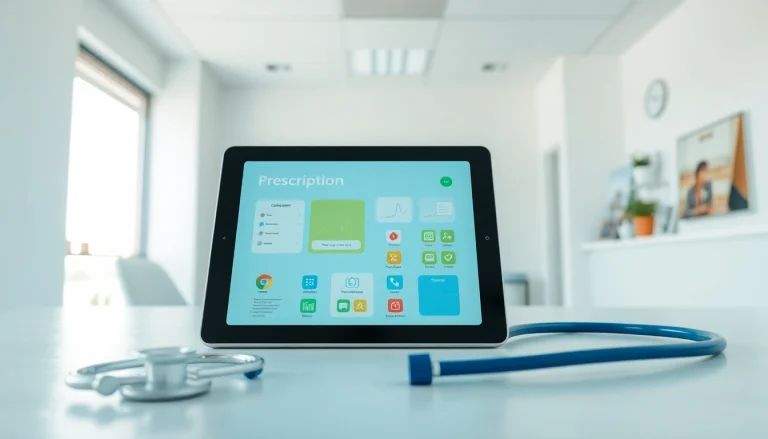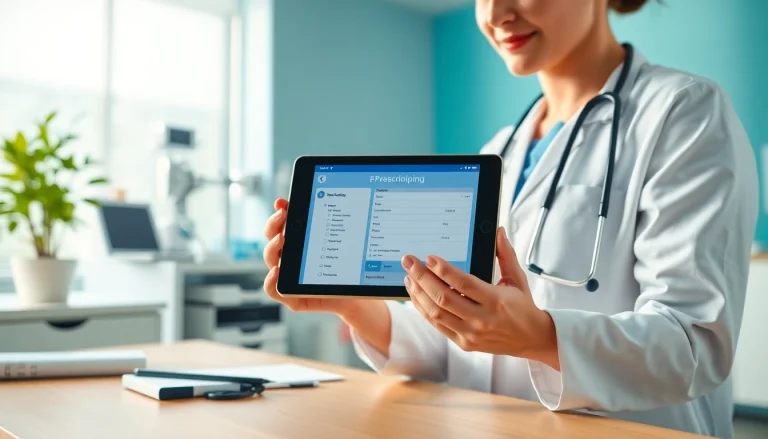
Understanding E-Prescription in Modern Healthcare
What is E-Prescribing?
E-prescribing, or electronic prescribing, is a digital method of generating and transmitting prescription orders from providers to pharmacies. This innovative technology has revolutionized the traditional paper-based method, allowing healthcare providers to send prescriptions directly to pharmacies via computer systems, smartphones, or tablets. By eliminating paper prescriptions, e-prescribing significantly reduces medication errors and enhances patient safety.
The use of e-prescribing systems streamlines the prescription process, allowing providers to easily check medication interactions, view patient histories, and ensure compliance with formulary guidelines. Patients benefit from quicker processing times, reduced wait at pharmacies, and improved communication with their healthcare providers. As more healthcare organizations adopt electronic health records (EHR) and mobile applications, the capability and importance of e-prescribing continue to grow. For those seeking options, outstanding platforms—often considered the best eprescription apps—are crucial in optimizing prescription accuracy and efficiency.
Benefits of E-Prescribing for Providers and Patients
The shift from paper to electronic prescriptions offers myriad benefits for both healthcare providers and patients. Here are some concrete advantages:
- Reduced Errors: The digital format allows for clearer communication and minimizes the chances of misreading handwriting, which is a common source of errors in traditional prescriptions.
- Improved Efficiency: E-prescribing enables quicker communication between healthcare providers and pharmacies, reducing the turnaround time for fulfilling prescriptions.
- Prescription Tracking: Providers can easily track prescriptions and ensure that patients receive their medications, facilitating better ongoing care.
- Patient Engagement: With access to their prescription information, patients become more involved in their treatment and medication management, fostering a sense of accountability.
- Enhanced Medication Management: Tools that flag potential drug interactions and allergies help providers ensure patient safety and optimize drug therapy.
Legal Compliance and Regulations in E-Prescribing
E-prescribing must adhere to strict regulations to ensure security and legality. In the United States, the Drug Enforcement Administration (DEA) sets specific requirements for electronic prescribing of controlled substances under the Electronic Prescriptions for Controlled Substances (EPCS) rule. Compliance with HIPAA regulations is also critical, as patient data must be protected from unauthorized access.
Healthcare providers using e-prescribing systems should ensure that their chosen platform meets all legal requirements, including secure data transmission, authentication procedures, and proper record-keeping. Understanding these regulations not only safeguards practices but also promotes trust with patients who rely on secure and reliable healthcare services.
Key Features of the Best E-Prescription Apps
User-Friendly Interface and Experience
The effectiveness of any e-prescribing app largely depends on its user interface (UI) and overall user experience (UX). A well-designed e-prescribing application should be intuitive, allowing healthcare providers to navigate easily without extensive training. Key features include:
- Clear Navigation: The app should enable users to access various features—like patient records, prescription history, and medication management—quickly.
- Customizable Options: Healthcare providers often have different needs; therefore, the ability to customize the interface can enhance usability significantly.
- Mobile Compatibility: As many providers work on-the-go, applications must be accessible via mobile devices to accommodate the busy lives of healthcare professionals.
Integration with Electronic Health Records (EHR)
Seamless integration with EHR systems is a must-have feature for any e-prescribing application. This integration ensures that patient records are consistently updated, allowing for a comprehensive view of patient health history. Benefits of EHR integration include:
- Holistic Patient Care: Providers can access updated medical histories, lab results, and prior prescriptions, which enhances medication accuracy.
- Time Savings: Integration eliminates the need for repetitive data entry, freeing up time for healthcare providers to focus more on patient care.
- Improved Interoperability: Ensuring that records can be shared among various healthcare providers fosters better collaboration and patient outcomes.
Security Features and Patient Data Protection
Given the sensitive nature of health information, robust security measures are essential in e-prescribing apps. Key security features to look for include:
- Data Encryption: The app should encrypt data both in transit and at rest to protect patient information from unauthorized access.
- User Authentication: Multi-factor authentication can enhance security, ensuring that only authorized users access sensitive data.
- Audit Trails: Keeping detailed audit logs allows for tracking of who accessed which data and when, reinforcing accountability.
Evaluating Popular E-Prescription Apps
Performance Metrics and User Reviews
Before selecting an e-prescribing app, it is critical to evaluate its performance metrics, which can provide insight into its reliability and effectiveness. Key metrics to consider include:
- Uptime: A reliable e-prescribing app should maintain a high uptime percentage, indicating that it is accessible when needed.
- User Satisfaction Ratings: Reviews from users can offer valuable perspectives on the app’s usability and features.
- Prescription Processing Speed: Efficiency in processing prescriptions can significantly impact the overall workflow for healthcare professionals.
Cost-Effectiveness and Pricing Models
When choosing an e-prescribing solution, budget considerations are paramount. Cost-effectiveness doesn’t just mean finding the cheapest option, but rather assessing the overall value provided by the software. Pricing models can vary widely:
- Subscription-Based: Many e-prescribing platforms operate on a monthly subscription basis, which can be a predictable cost for practices.
- Pay-Per-Use: Some apps charge per prescription but may lack features found in subscription models.
- One-Time Licensing Fee: Although less common, some software solutions operate with a one-time fee, requiring less ongoing budget commitment.
Support and Training Options
Access to customer support and training is essential for the successful implementation of e-prescribing solutions. When evaluating apps, consider the following:
- Training Resources: Comprehensive training materials, such as instructional videos and manuals, can streamline the onboarding process for staff.
- Customer Support: Reliable and available customer support can help resolve issues quickly, ensuring minimal disruption in workflows.
- Community Support: Forums or online communities can offer additional support, enabling users to share experiences and best practices.
Implementing E-Prescription Solutions in Your Practice
Steps to Successfully Transition to E-Prescribing
Transitioning to an e-prescribing system involves strategic planning and execution. Here are the steps to facilitate this change:
- Assess Current Processes: Begin with an evaluation of your existing prescription practices and identify pain points that can be alleviated through e-prescribing.
- Choose the Right Software: Review and select the e-prescribing app that best meets your practice’s needs, focusing on integration, features, and support.
- Develop an Implementation Plan: Outline a timeline for rollout, including key milestones for training and integration with existing systems.
Training Staff on New E-Prescription Platforms
Once the e-prescribing app has been selected, creating a training program for staff is vital. Effective training ensures that all team members are comfortable with the new system, which can lead to smoother transitions and better patient care. Key elements of a training program should include:
- Hands-On Workshops: Conduct interactive workshops that allow staff to practice using the software in real-time scenarios.
- On-Demand Resources: Provide resources that staff can refer back to as needed, including quick reference guides and FAQs.
- Feedback Mechanisms: Implement ways to gather feedback during training to adjust components as necessary for better efficacy.
Monitoring and Improving E-Prescribing Efficiency
After the implementation phase, it is essential to monitor the efficiency of the e-prescribing system continuously. Key performance indicators (KPIs) can provide valuable insights into how well the system is performing, guiding improvements over time. Important KPIs include:
- Prescription Completion Rates: Tracking how many prescriptions get filled can identify potential bottlenecks.
- Time Spent on Prescriptions: Evaluating how long it takes to process prescriptions can highlight opportunities for increasing efficiency.
- Patient Feedback: Regular surveys soliciting patient feedback can provide insights into the patient experience and identify areas for improvement.
Future Trends in E-Prescribing Technology
Advancements in E-Prescribing Software
As technology continues to evolve, so too do the possibilities for e-prescribing software. Emerging advancements paint a promising picture for future application features, including:
- Mobile Optimization: Enhanced mobile capabilities will likely dominate future e-prescribing apps, making it easier for providers to manage prescriptions on-the-go.
- Customization Using AI: Machine learning and AI may enable software to analyze prescribing patterns and suggest personalized medication options based on patient history.
- Expanded Integrations: Future apps may provide expanded integrations with wearables and health trackers, creating a more holistic approach to patient care.
The Role of Artificial Intelligence in E-Prescribing
Artificial intelligence (AI) is poised to play a significant role in the development of e-prescribing applications. By analyzing vast amounts of data, AI can identify potential drug interactions, recommend dosage adjustments, and predict adherence challenges. As AI technology advances, it may even personalize prescribing practices based on demographic and behavioral data, further enhancing patient safety and care quality.
Impact of Telemedicine on E-Prescribing Practices
The rise of telemedicine has created new dynamics in the prescription landscape. With more patients utilizing virtual consultations, healthcare providers require robust e-prescribing solutions that seamlessly integrate with telehealth platforms. This integration boosts the efficiency of remote care by allowing providers to instantly send prescriptions to pharmacies during virtual visits, enhancing patient convenience and encouraging medication adherence.






